Understanding what size bike you need can be tricky, and if you don’t know where to start, it can feel like trying to navigate a maze.
There are multiple frame sizes to consider, and sizing methods differ based on your riding style and preferred manufacturer.
But finding the right bike size is actually easier than it seems!
We’ve created this guide to simplify and demystify the process, answering any questions you might have.
Our bike sizing guide has already been read 10 million times, proving its effectiveness and helping riders like you make informed decisions. Join the millions who’ve found their perfect fit.
By the end, you’ll have a much clearer understanding of how to choose the perfect bike size for your needs.
Please read: Google killed this Bike Size page!
Contents
Why Trust Us?
Why should you trust our bike sizing guide?
It’s simple: 10 million readers can’t be wrong. See for yourself:
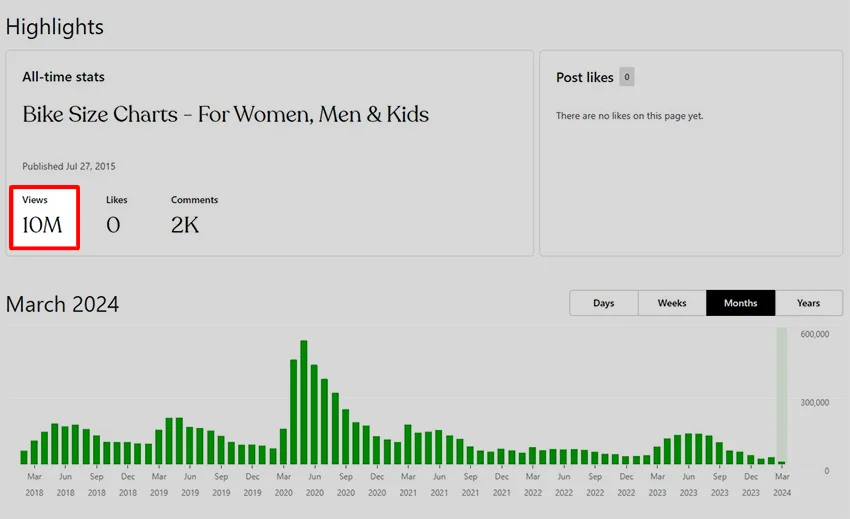
Our guide has not only been read by millions trying to find their ideal bike size, but we’ve also directly assisted over 1000 individuals find their perfect fit in the comments.
With years of experience both as cyclists and helping others find their way in the cycling world, our bicycle sizing insights and tips come from real-life experience.
If you still have questions or need further guidance after reading the bike frame size charts below, feel free to reach out in the comments and we’ll help you find the perfect bike size for your height.
How to Get the Right Bike Size?
Choosing the right bike size is essential for comfort, efficiency, and preventing injuries.
While test riding a bike is the ideal way to gauge fit, it’s not always practical, especially with the often better deals found online compared to local bike shops.
The good news is, you DON’T NEED TO test ride a bike to ensure a good fit.
If you know your height and inseam length, you can get the right size by using a bike size chart.
However, this is where things get slightly more complex.
Bike manufacturers may use different sizing standards, such as centimeters and inches, or sizing labels such as S, M, L, XL. Sizing methods also differ based on bike types—road, mountain, and hybrid bikes are not sized in the same way.
If you’re starting to feel overwhelmed, don’t worry. Keep reading below and we’ll make things a lot clearer.
Should You Trust S, M, L, XL Bike Size Labels?
Many manufacturers also use size labels such as XS, S, M, L, and XL. These labels are becoming more common because they simplify things, but they can sometimes be vague and misleading.
Due to the lack of standardization across brands and bike types, you should avoid relying only on bike size labels when choosing the right size. Their dimensions may vary from one brand to another.
Letter-based size labels offer a good starting point but should be cross-checked with other methods.
For example, an L-sized Trek road bike may have a 56 cm seat tube length, while a Giant’s L-sized road bike may have a 58 cm seat tube length.
Therefore, you can use these labels as a rough guide, but make sure to also refer to a bike type-specific size chart (such as the ones below) or the manufacturer’s sizing chart for the specific model you’re interested in.
What and How to Measure?
To be able to use a bike frame size chart and correctly size a bike, you need to know two measurements: height and inseam (inside leg) length.
Why does inseam length matter?
The inseam length is important to ensure you get a bike with an appropriate standover height. This is the distance from the ground to the top of the bike’s top tube.
Ideally, to prevent injury and improve comfort, there should be a one-to-two-inch clearance between your crotch and the top tube when standing over the bike.
What you’ll need:
- A tape measure
- A book
- 30 seconds of your time
Measuring your height is super simple. All you need to do is:
- Stand straight against a wall with your feet together.
- Place a book on top of your head, making sure it’s horizontal with the floor.
- Measure the distance from the ground to the point where the book and the wall meet.
Measuring your inseam is even simpler:
- Just stand against a wall with your shoes off and feet hip-width apart.
- Measure the distance from the ground to your crotch.
- That’s it!
With these two measurements written down, you’re pretty much all set to find the perfect bike size for your height and inseam.
Adult Bikes Are Sized by the Frame
Adult bikes are primarily sized by the frame; or to be more specific, they are sized by the seat tube length.
This is the vertical distance from the center of the pedal axle (the bottom bracket) to the top of the seat tube—it’s often listed in measurements like 52 cm, 54 cm, 56 cm, or 17 inches, 19 inches, 21 inches.
While this measurement is a good starting point, it doesn’t tell us all that we need to know—it determines the height of the bike, but not its length, also known as reach.
Why Does Reach Matter?
To really dial the fit, you should also consider the bike’s reach, which refers to the horizontal distance between the bottom bracket and the head tube.
Reach tells you how far you have to stretch to reach the handlebars and is especially useful if you’re in between two sizes.
A shorter reach means you’ll be sitting more upright when you’re riding—perfect for comfort on longer rides.
A longer reach means you’ll be more stretched out on the bike—ideal if speed and aerodynamics are your priorities.
Men’s vs. Women’s Bike Sizing
In adult bike sizing, the distinction between men’s and women’s bikes often comes down to marketing rather than significant sizing and design differences.
Therefore, the bike frame size charts below are suitable for all riders, regardless of gender.

Even though some brands offer models specifically labeled for men or women, and a few brands manufacture women’s bikes only (such as Liv or Juliana), the differences compared to unisex bikes are miniscule.
Men’s and women’s bike sizes are largely similar, with only minor differences driven by marketing. Most bikes are unisex!
These often include slightly different proportions between the bike’s stack (vertical height) and reach (horizontal length), which are negligible unless you’re a professional rider.
For example, women’s models might have a shorter reach compared to the stack to accommodate what some manufacturers perceive as average body proportions.
However, as body types differ among individuals, a women-specific bike might not automatically provide a better fit for every woman. Similarly, some men might find that a women-specific model fits them better than a men’s or unisex model.
Kids’ Bike Sizing: Sized by Wheel Diameter
Unlike adult bikes which are measured by frame size, kids’ bikes are determined by wheel size, simplifying the selection process.
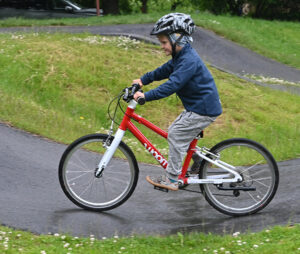
Wheel diameters on kids’ bikes typically range from 12 inches to 26 inches, increasing in two-inch increments. This means that a 12-inch kids’ bike has 12″ wheels, a 14-inch bike has 14″ wheels, and so on.
Manufacturers then use these wheel size measurements to provide size recommendations based on a child’s age, inseam length, or height.
For example, a 12-inch bike might be suggested for children ages 3 to 5, with specific height or inseam measurements to further dial the best fit.
Many manufacturers provide additional information such as standover height and min/max seat height, which allows parents to get a better fit by relying on the inseam length measurement.
While wheel diameter and age can give a general idea of the right bike size, incorporating inseam length in the equation is advisable for the perfect fit.
Jump to Kids Bikes Sizing
Sizing by Bike Types
While most adult bikes are sized by the frame, specifically by the seat tube length, sizing standards can differ slightly based on bike types.
For example, road bikes are typically measured in centimeters (cm), mountain bikes are measured in inches (in), while hybrid bikes may use either of the two.
Therefore, finding the ideal fit means you should be checking out bike type-specific sizing charts for road, mountain, and hybrid bikes, such as the ones below!
Mountain Bike Size Chart
In recent years, mountain bike manufacturers have moved away from the traditional method of sizing bikes by inches and seat tube lengths.
Nowadays, a more intuitive system using size labels such as S, M, L, and XL is in use, prompted by more radical modern frame designs and geometries.
In addition to that, most brands also provide detailed geometry charts where you can find important measurements such as stack, reach, tube angles, wheelbase, and so on.
Our mountain bike size chart below is a great starting point.
| Rider Height | Leg Inseam | Suggested Frame Size | |||
| Feet/Inches | Centimeters | Inches | Centimeters | Inches | Size Labels |
| 4’10” – 5’1” | 148 – 158 cm | 24″ – 29″ | 61 – 73 cm | 13″ – 14″ | XS |
| 5’1″ – 5’5″ | 158 – 168 cm | 25″ – 30″ | 63 – 76 cm | 15″ – 16″ | S |
| 5’5″ – 5’9″ | 168 – 178 cm | 26″ – 31″ | 66 – 78 cm | 17″ – 18″ | M |
| 5’9″ – 6’0″ | 178 – 185 cm | 27″ – 32″ | 68 – 81 cm | 18″ – 19″ | L |
| 6’0″ – 6’3″ | 185 – 193 cm | 28″ – 33″ | 71 – 83 cm | 19″ – 21″ | XL |
| 6’1″ – 6’6″ | 193 – 198 cm | 29″ – 34″ | 73 – 86 cm | 22″ – 24″ | XXL |
26-Inch vs. 27.5-Inch vs. 29-Inch Wheels
Modern mountain bikes typically come with 27.5-inch or 29-inch wheels, whereas 26-inch wheels are mostly reserved for fat-tire bikes.
The choice of wheel size directly influences the bike’s handling and performance—smaller wheels improve handling and maneuverability, whereas larger wheels enhance speed and obstacle rollover ability.
However, when considering the right fit for a mountain bike, the impact of wheel sizes is limited and more nuanced.
In general, wheel sizes should not be used as a way to gauge the right fit of a mountain bike, even though it can affect the riding experience by changing the geometry of the bike.
Wheel size is crucial for riding performance, but not as important for sizing adult bikes.
For shorter riders, smaller wheels can improve the feeling of maneuverability and control, improving the riding experience. Smaller wheels also lower the standover height, which has a positive effect on comfort and safety.
Conversely, taller riders may prefer larger 29-inch wheels for smoother handling and the ability to maintain momentum.
This is why many manufacturers often align wheel sizes with frame sizes—smaller frames come with 27.5-inch wheels, whereas larger frames come with 29-inch wheels.
What If You’re Between Two Sizes?
If you find that you’re between two sizes on our mountain bike frame size chart, there are a few things you should consider to be able to choose correctly.
- Riding style: Size up if you’re an aggressive rider or size down if you’re more timid in your approach.
- Stability vs. maneuverability: If you prioritize stability, size up; but if you prioritize maneuverability, size down.
- Approaching obstacles: If you prefer taking the harder line and going over obstacles rather than around them, size up. Otherwise, size down.
- Ape index: If your wingspan is longer than your height, size up; otherwise, size down.
- Experience and flexibility: If you are an experienced rider and have a flexible body, feel free to size up. Otherwise, size down to feel more confident.
Road Bike Size Chart
Road bikes are typically sized in centimeters by measuring seat tube length. Most manufacturers also use the letter-based size labels.
However, with the introduction of modern frame geometries with sloping top tubes, it’s a good idea to also consider more advanced geometry measurements, such as stack and reach.
This approach offers a more precise fit, ensuring optimal performance and comfort on the road.
Below, our road bike size chart offers the perfect starting place to pinpoint your ideal frame size.
| Rider height | Leg Inseam | Suggested Frame Size | |||
| Feet/Inches | Centimeters | Inches | Centimeters | Centimeters | Size Labels |
| 4`10” – 5`0” | 148 – 152 cm | 24″ – 29″ | 61 – 73 cm | 47 – 48 cm | XXS |
| 5`0″ – 5`3″ | 152 – 160 cm | 25″ – 30″ | 63 – 76 cm | 49 – 50 cm | XS |
| 5`3″ – 5`6″ | 160 – 168 cm | 26″ – 31″ | 66 – 78 cm | 51 – 53 cm | S |
| 5`6″ – 5`9″ | 168 – 175 cm | 27″ – 32″ | 68 – 81 cm | 54 – 55 cm | M |
| 5`9″ – 6`0″ | 175 – 183 cm | 28″ – 33″ | 71 – 83 cm | 56 – 58 cm | L |
| 6`0″ – 6`3″ | 183 – 191 cm | 29″ – 34″ | 73 – 86 cm | 58 – 60 cm | XL |
| 6`3″ – 6`6″ | 191 – 198 cm | 30″ – 35″ | 76 – 89 cm | 61 – 63 cm | XXL |
Note: This chart can also be used to find the right gravel and cyclocross bike size due to their similarity to road bikes.
What If You’re Between Two Sizes?
If you’re between two sizes on our road bike size chart above, you’ll want to consider these factors before making the final choice:
- Riding for speed: If you prefer faster and shorter rides and races (such as crits), choose a smaller frame.
- Riding for endurance: If you prefer long-distance riding, such as gran fondos or audaxes, choose a bigger frame.
- Ape index: If your wingspan is longer than your height, choose a bigger frame. Otherwise, choose a smaller frame.
- Riding position: If you prefer being more upright when riding, choose a smaller frame. Otherwise, choose a bigger frame for more aerodynamics.
- Weight and stiffness: If you want a bike that feels stiffer and lighter (e.g. for sprinting), choose a smaller frame.
Hybrid Bike Size Chart
Hybrid bikes blend the characteristics of road and mountain bikes, prioritizing comfort, practicality, and versatility.
Most manufacturers size hybrid bikes (including commuting and fitness bikes) using the letter-based approach (S, M, L, XL).
This makes it easy to find the right size, especially considering the fact these bikes are used for recreation and commuting, rather for performance.
Choose your ideal hybrid bike size from the chart below.
| Rider Height | Leg Inseam | Suggested Frame Size | |||
| Feet/Inches | Centimeters | Inches | Centimeters | Inches | Size Labels |
| 4`10” – 5`1” | 147 – 155 cm | 24″ – 29″ | 61 – 73 cm | 14″ | XS |
| 5`1″ – 5`5″ | 155 – 165 cm | 25″ – 30″ | 63 – 76 cm | 15″ | S |
| 5`5″ – 5`9″ | 165 – 175 cm | 26″ – 31″ | 66 – 78 cm | 16″ | M |
| 5`9″ – 6`0″ | 175 – 183 cm | 27″ – 32″ | 68 – 81 cm | 17″ | L |
| 6`0″ – 6`3″ | 183 – 191 cm | 28″ – 33″ | 71 – 83 cm | 18″ | XL |
| 6`1″ – 6`6″ | 191 – 198 cm | 29″ – 34″ | 73 – 86 cm | 19″ | XXL |
What If You’re Between Two Sizes?
If you’re between two sizes on our chart above, here are a few things to consider:
- Ape index: If your wingspan is longer than your height, choose the larger frame size.
- Riding style: If you plan to ride for leisure or commuting, a larger frame might offer a more relaxed posture. For more sporty fitness riding, a smaller frame will provide better control and handling.
- Standover height: Make sure your inseam length is at least 1-2 inches longer than the standover height on the frame size you’re considering.
Kids’ & Junior’s Bike Size Charts
As we’ve already mentioned briefly above, kids’ bikes are sized by the wheel diameter. This makes choosing the right size a lot more straightforward.
Check out our kids’ bike size chart below to get a general idea of which sizes to consider for your child.
But remember, for the best fit, it’s a good idea to measure your child’s inseam and compare it to the bike’s standover height and seat height range.
|
Wheel Size |
Age |
Height (In) |
Height (Cm) |
Leg Inseam (In) |
Leg Inseam (Cm) |
| 10″ | 2 – 3 | 2’9″ – 3’1″ | 85 – 90 cm | 12″ – 14″ | 85 – 90 cm |
| 12″ | 3 – 4 | 3’1″ – 3’3″ | 90 – 100 cm | 14″ – 17″ | 35 – 42 cm |
| 14″ | 4 – 5 | 3’3″ – 3’7″ | 100 – 110 cm | 16″ – 20″ | 40 – 50 cm |
| 16″ | 5 – 6 | 3’7″ – 3’8″ | 110 – 115 cm | 18″ – 22″ | 45 – 50 cm |
| 18″ | 6 – 8 | 3’8″ – 4’0″ | 115 – 120 cm | 20″ – 24″ | 50 – 60 cm |
| 20″ | 7 – 9 | 4’0″ – 4’5″ | 120 – 135 cm | 22″ – 25″ | 55 – 63 cm |
| 24″ | 9 – 11 | 4’5″ – 4’9″ | 135 – 145 cm | 24″ – 28″ | 60 – 72 cm |
| 26″ | 11 – 14 | 5’+ | 145 cm + | 28″+ | 72 cm+ |
How to Know If a Bike Fits You Well
Finding the right bike size using a sizing chart is pretty straightforward and a great start.
But how do you know if your bike actually fits you perfectly?
Here’s a quick checklist to help you easily determine if your bike fits you well.
- Standover height: If the bike fits you well, there should be 1-2 inches of space between your crotch and the bike’s top tube. This is especially important on bikes with a horizontal top tube design. To check, stand over the bike with your feet flat on the ground and pull the handlebars up. If the front wheel can come up 1-2 inches, you’re good to go.
- Saddle height: With your foot on the pedal at its lowest point (6 o’clock), your leg should have only a slight bend in the knee. A good fit shouldn’t require the saddle to be at its maximum or minimum height setting for you to achieve this.
- Reach: How does it feel holding the handlebars while sitting on the saddle and riding? If you feel the handlebars are too far away and you need to stretch to reach them, the bike is likely too big. However, if you feel cramped and constrained with a rounded back and shoulders, you should probably size up.
- Overall comfort: Do you feel comfortable and confident while riding the bike? If the bike fits well, you should be able to handle and maneuver it with ease, especially when cornering and accelerating on the pedals.
- Knee position: Finally, if the bike fits you well, your knee should not be hitting the handlebars when pedaling. Also, the front of your foot should not be hitting the front wheel when turning the handlebars. If this happens, you need to size up.
Frequently Asked Questions
What size push bike do I need?
Push bikes are typically sold with 10" - 14" wheels. A 10-inch push bike will usually fit kids aged 18 months to 2 years; a 12-inch push bike will fit kids aged 2-4 years; while a 14" push bike will typically fit kids aged 3-5 years old. These are just general recommendations—for the best fit, consider your child's inseam length.
What size bike do I need for my height?
To find out what size bike you need for your height, you should consult a sizing chart for the type of bike you're interested in, such as road, mountain, or hybrid. Depending on the type, bike size charts will match your height to a corresponding frame size denoted in centimeters, inches, or general sizes (XS, S, M, L, XL).
Is a 26-inch bike for adults?
A 26-inch bike can be suitable both for adults and for kids, depending on the context. Kids' 26-inch bikes are suitable for teenagers and shorter adults. However, some adult bikes, such as touring bikes, fat bikes or electric bikes, also come with 26-inch wheels, but these have larger frames and are not suitable for children.
What height is a 26-inch bike good for?
A kids' 26-inch bike (a bike with 26-inch wheels) is typically suitable for teenagers and shorter adults who are around 5'0" to 5'3" tall. However, bikes for adults with 26-inch wheels, such as fat bikes or some electric bikes, are often available in a few frame sizes and might fit adults who are 6 feet in height and taller.
How do I know if a bike is too big or too small?
A bike is considered too big if you cannot stand over the frame with both feet flat on the ground without the top tube touching your crotch, or if you have to stretch too far forward to reach the handlebars. Conversely, it's considered too small if you feel cramped when riding, can't adjust the seat high enough, or your knees hit the handlebars when pedaling.
___ Inch bike for what size person?
To determine which bike size is suitable for a particular height range, consult a specialized bike size chart for the bike type you're interested in, such as our road, mountain, and hybrid size charts above. These charts match rider heights with appropriate bike sizes, allowing you to get a proper fit.


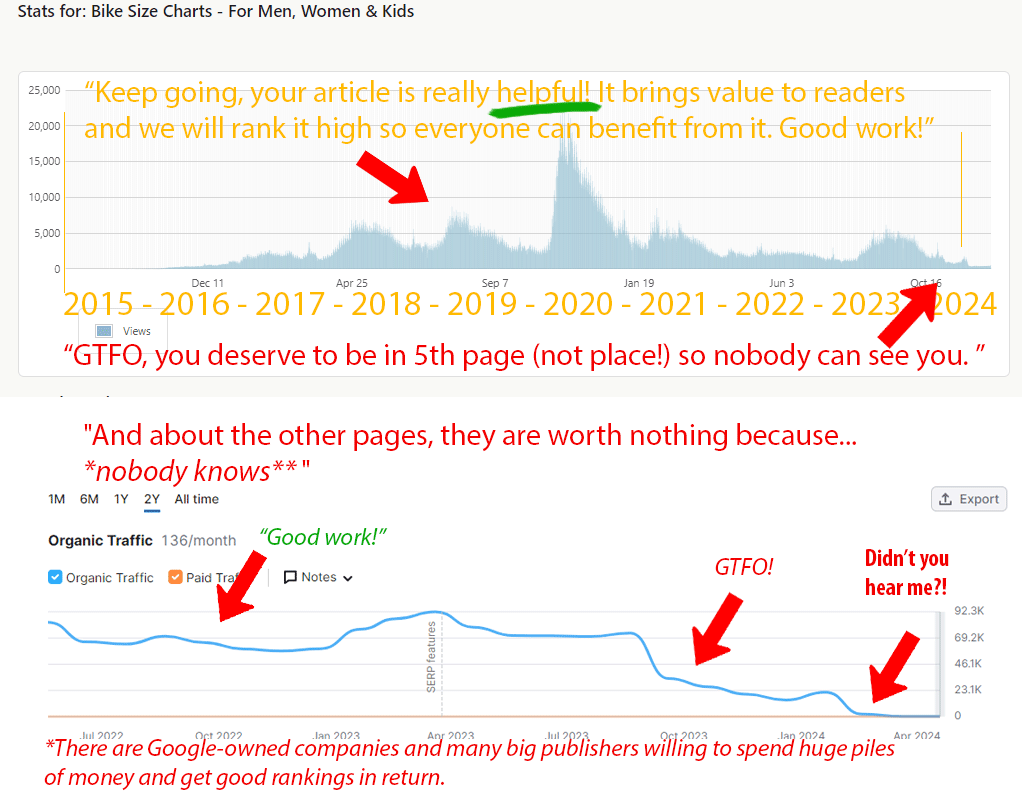
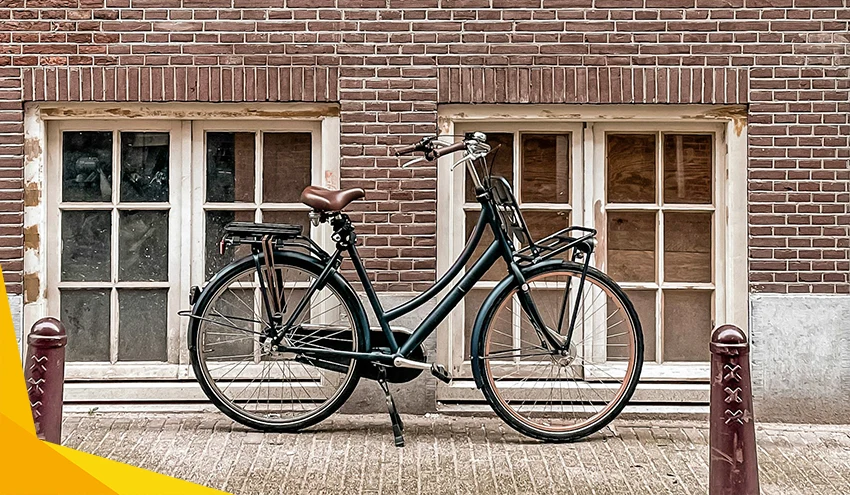
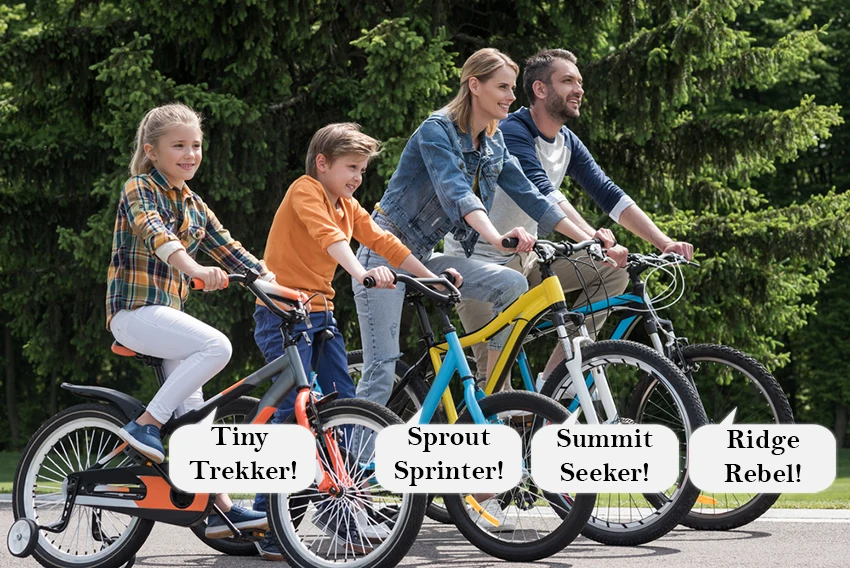
This blog post hit all the right notes!
It’s always a joy to stumble upon content that genuinely makes an impact and leaves you feeling inspired. Keep up the great work!
Thank you for the amazing blog post!